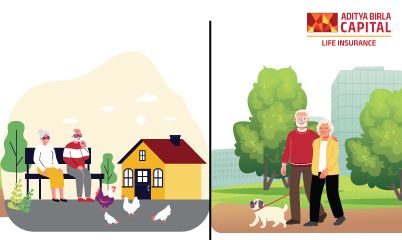The place you live plays a vital role in retirement planning because it determines the kind of retirement you can expect and the financial strategies you'll need to employ. India's diversity in city types, from bustling metro cities like Mumbai and Delhi to serene small towns in Rajasthan or Tamil Nadu, means that planning needs to be tailored to suit these environments.
The cost of living is usually higher in metro areas because of the more expensive housing, transit, and daily necessities. Contrastingly, small towns offer a relatively lower cost of living, with cheaper housing and lifestyle options. This fundamental difference impacts how much you need to save and the investments you might consider to ensure a comfortable retirement. Knowing these distinctions might help you make decisions that align with your desired retirement lifestyle and long-term financial goals.
Cost of Living Comparison: Housing, Utilities, Groceries, and Transportation
The cost of living significantly varies between metro cities and small towns, impacting key expenses like housing, utilities, groceries, and transportation. Here's a breakdown to give you a clearer picture based on 2025 data:
| Expense Category | Metro City (Estimated Average Cost) | Small Town (Estimated Average Cost) |
|---|
| Housing | ₹25,000 – ₹60,000/month | ₹6,000 – ₹18,000/month |
| Utilities | ₹3,500 – ₹6,000/month | ₹1,200 – ₹3,500/month |
| Groceries | ₹8,000 – ₹12,000/month | ₹3,500 – ₹6,000/month |
| Transportation | ₹6,000 – ₹9,000/month | ₹1,500 – ₹3,500/month |
These 2025 estimates reflect an approximate 8–10% rise in metro living costs over the past year, driven by rent inflation and higher fuel prices (Knight Frank India Housing Price Index Q2 2025; MOSPI CPI Data, August 2025).
Healthcare Access and Costs: Availability and Cost Variations in Different Regions
Access to healthcare is a critical factor in retirement planning, as healthcare needs typically increase with age. The availability and cost of healthcare services can vary greatly between metro cities and small towns.
| Healthcare Aspect | Metro City Advantages | Small Town Challenges |
|---|
| Availability | High: Wide range of multi-specialty hospitals and clinics. | Limited: Fewer healthcare facilities, which may require travel to nearby cities for specialised care. |
| Cost | Higher: Due to the availability of advanced healthcare services. | Lower: Basic healthcare services are generally less expensive, but costs can rise significantly if travelling to cities for treatment. |
In 2025, healthcare inflation in India is estimated at 10.7%, with urban areas seeing sharper cost increases (RBI Bulletin, July 2025). Meanwhile, IRDAI’s Annual Report 2025 notes an average 8–10% rise in senior citizen health insurance premiums due to rising medical claims. Understanding these differences can help you plan not only where to retire but also how to budget for healthcare, ensuring you have access to the necessary services without compromising on quality.
Lifestyle Considerations: Social Activities, Entertainment, and Community Services
The choice between retiring in a metro city versus a small town extends beyond just economic factors, it also encompasses lifestyle considerations, which are crucial for a fulfilling retirement.
Metro Cities
Metro cities offer numerous social activities, diverse entertainment options, and extensive community services. From theatres, museums, and concerts to various clubs and community groups, metro cities cater to numerous interests and hobbies. The vibrant social life in these cities can greatly enhance your quality of life during retirement, providing ample opportunities to stay active and engaged.
Small Towns
Small towns often boast close-knit communities with a slower pace of life. Social events include local fairs, get-togethers with the community, and more closely-knit groups. The lack of variety in entertainment options when compared to larger towns can be compensated for by stronger bonds and a strong sense of community. In addition, many retirees enjoy the peace and beauty of smaller communities as it may be ideal for pastimes like hiking, gardening, and painting.
Financial Planning Strategies: Tailored Advice for Each Scenario
For Metro City Dwellers
- Budget More for Living Expenses: Given the higher cost of living, allocate a significant part of your retirement savings to cover monthly expenses. Consider investments that offer stable returns to manage regular expenses.
- Invest in Health Insurance: A comprehensive health insurance plan is crucial for higher healthcare costs. Look for plans that offer extensive coverage, including treatments at multi-specialty hospitals.
- Plan for Leisure Activities: Set aside funds, particularly for social and cultural activities, which are abundant but can be expensive.
For Small Town Residents
- Save for Travel and Health: While everyday expenses are lower, you might need to travel to nearby cities for healthcare and entertainment, which can add up. Creating a travel fund is a wise decision.
- Invest in Community Bonds: You can improve your social life and financial portfolio by getting involved in local investment possibilities or community development.
- Healthcare Access: Invest in a health insurance plan that covers treatments in both your town and larger cities, ensuring you're covered no matter where you need to go for medical care.
By understanding and planning for these differences, you can tailor your retirement strategy to ensure it aligns with the lifestyle you envision and the community where you will spend your retirement years. This comprehensive approach ensures that you can enjoy your retirement, be secure in your financial stability, and stay engaged with your environment.
Examples
Scenario 1: Retiring in a Metro City – Rajesh’s Story
Rajesh, a 60-year-old former IT professional, planned his retirement in Bengaluru, one of India's major metro cities. He owns a modest apartment in a busy part of the city near medical facilities, retail establishments, and cultural attractions. His children live abroad, so having access to an international airport is important for him.
Financial Setup:
- Savings: Considering the high cost of living, Rajesh has invested a large percentage of his savings in mutual funds and fixed deposits designed to provide a consistent income.
- Expenses: Monthly expenses average around ₹55,000–₹60,000, covering utilities, groceries, healthcare, and occasional outings.
- Social Life: He is an active member of a local book club and often attends plays and art exhibitions, which keeps him socially and mentally active.
Scenario 2: Retiring in a Small Town – Meena’s Story
Meena, a 55-year-old retired school teacher, chose to move to a small town in Himachal Pradesh after retiring. She purchased a cottage with a beautiful view of the mountains, which has always been her dream. The slower pace of life and lower cost of living allow her to enjoy her hobbies, including gardening and bird watching.
Financial Setup:
- Savings: Most of Meena's investments are in senior citizen savings plans, with a tiny amount going toward local real estate that generates extra cash.
- Expenses: Her monthly living expenses are about ₹22,000, mainly for groceries, utilities, and local transportation.
- Healthcare: While the local clinic covers basic health needs, she has a contingency fund for travel expenses to a city hospital for serious health issues.
Final Thoughts
In conclusion, planning for retirement involves more than just saving money; it's about strategically aligning your financial resources with your desired lifestyle and choosing a location that best suits your needs. Whether you pick the quiet, small-town ambience with a strong sense of community or the bustling, resource-rich environment of a metropolis, each place presents unique benefits and difficulties. Careful consideration of living costs, healthcare access, and social opportunities is essential. It is possible to guarantee a happy and satisfying retirement by customising your plan to fit your financial situation and lifestyle choices.
Sources:
-
Reserve Bank of India (RBI) – Handbook of Statistics on the Indian Economy 2025
https://rbi.org.in/Scripts/AnnualPublications.aspx?head=Handbook%20of%20Statistics%20on%20the%20Indian%20Economy
-
Ministry of Statistics & Programme Implementation (MOSPI) – Consumer Price Index Report, August 2025
https://www.mospi.gov.in
-
Knight Frank India – India Real Estate: Housing Price Index Q2 2025
https://www.knightfrank.com/research
-
Insurance Regulatory and Development Authority of India (IRDAI) – Annual Report 2024–25
https://irdai.gov.in/en/reports/annual-reports/
-
Business Standard – Cost of Living and Retirement Expense Trends 2025
https://www.business-standard.com/
-
The Times of India – India’s Cost of Living and Inflation Trends 2025
https://timesofindia.indiatimes.com/business









